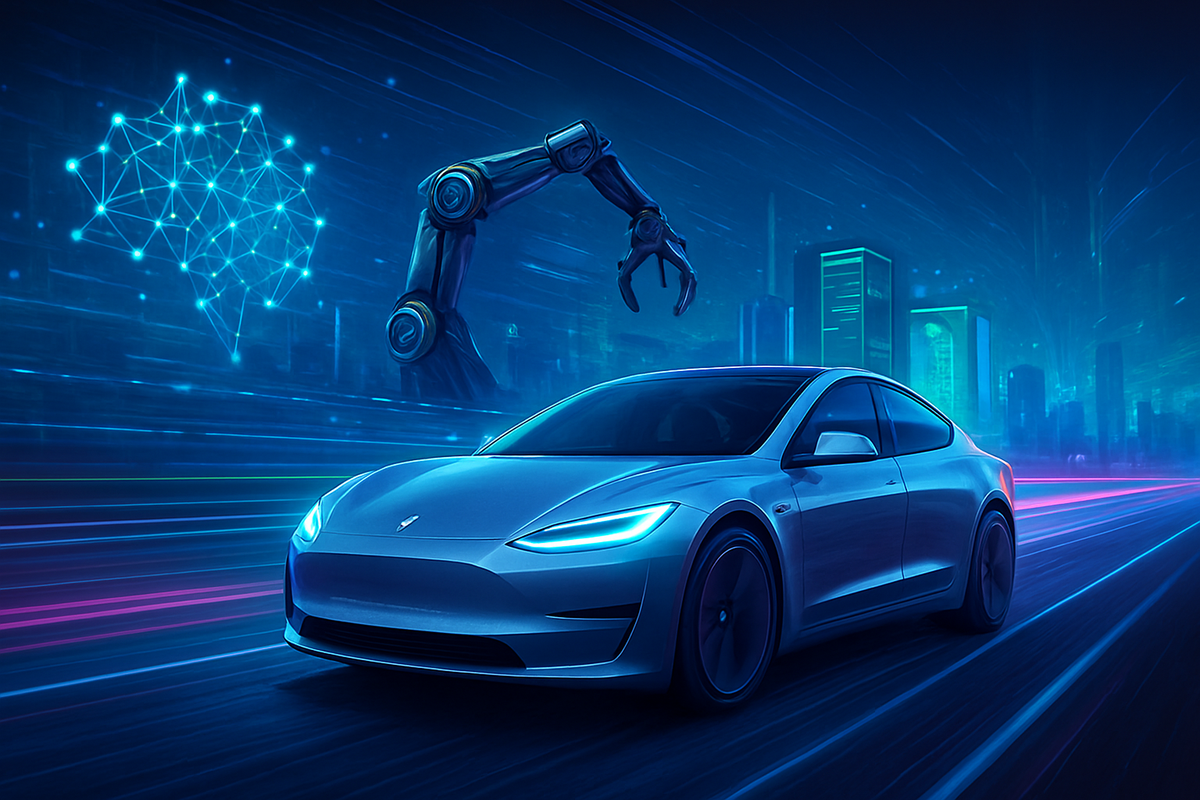Tesla (NASDAQ: TSLA): A Large-Cap Powerhouse Navigating the Future of Tech and Transport

As of November 11, 2025, Tesla (NASDAQ: TSLA) continues to command attention as a top-tier large-cap stock, albeit within a complex and rapidly evolving market landscape. The company's valuation, currently ranging between $1.45 trillion and $1.53 trillion USD, reflects not just its dominance in electric vehicles (EVs) but also aggressive investor expectations for its ventures into artificial intelligence (AI), robotics, and energy solutions. Despite a high price-to-earnings (P/E) ratio that signals significant future growth is already priced in, Tesla's strategic diversification and relentless innovation position it as a pivotal player in multiple disruptive technologies.
The immediate implications for investors are a blend of high-growth potential in diversified segments like energy storage and AI, coupled with inherent volatility stemming from intense competition in the EV sector, profitability pressures, and the execution risks associated with its ambitious projects. The wide divergence in analyst price targets, ranging from $19.05 to $600 per share, underscores the profound uncertainty and the high-stakes nature of Tesla's multifaceted growth narrative.
Tesla's Dynamic Year: From Record Deliveries to AI Ambitions
The period from late 2024 through November 2025 has been a whirlwind for Tesla, marked by significant product unveilings, strategic expansions, and fluctuating financial performance. The company's journey highlights its aggressive push to maintain leadership while diversifying its technological footprint.
Timeline of Key Events:
- October 10, 2024: Tesla unveiled its "Cybercab," a purpose-built autonomous robotaxi, with production slated for 2026.
- October 23, 2024: Q3 2024 earnings beat EPS expectations, leading to a remarkable 22% single-day surge in Tesla's stock.
- Late 2024: Tesla secured preliminary approval for its Full Self-Driving (FSD) technology in China, causing another stock jump. The Shanghai Megafactory for energy storage was completed, starting production in February 2025.
- January 29, 2025: Q4 2024 earnings missed revenue and EPS expectations, impacting the stock initially.
- Early 2025: Tesla announced plans for 10 new Gigafactories globally, including Mexico, India, and China, to expand manufacturing across its product lines.
- February 19, 2025: Tesla outlined a three-pronged growth strategy: new affordable models (dubbed "Model Q"), FSD expansion, and increased production of its Optimus humanoid robot.
- March 7, 2025: A revolutionary aluminum-ion battery, promising 745 miles of range and rapid charging, was announced, with integration targeted within 18-24 months.
- April 22, 2025: Q1 2025 earnings reported significant misses in EPS and revenue, with vehicle deliveries down 13% year-over-year, leading to a roughly 38% year-to-date stock decline.
- June 2025: Tesla launched a limited Robotaxi service in Austin, Texas, expanding to the San Francisco Bay Area in August.
- July 23, 2025: Q2 2025 earnings met EPS but surpassed revenue forecasts, though vehicle deliveries continued to decline year-over-year.
- October 22, 2025: Q3 2025 earnings reported record revenue of $28.1 billion (up 12% YoY) and record vehicle deliveries (497,099 units, up 7% YoY). Energy storage deployments surged 81% YoY to 12.5 GWh. However, GAAP net income declined 37% YoY to $1.37 billion, and operating income fell 40% YoY, indicating profitability pressures. Tesla also unveiled "Megablock," a next-generation industrial storage product, and new v4 Supercharger cabinets.
- November 6, 2025 (Annual Shareholders Meeting): Shareholders approved an unprecedented compensation package for CEO Elon Musk. Tesla announced a Cybercab production breakthrough (one every 10 seconds), plans for robotaxi deployment across U.S. cities, an upgraded Tesla Semi, and the construction of a new Gigafactory Texas facility for Optimus robot production (slated for 2027). A "Tera-Cell" battery technology, claiming 40% increased energy density and 600+ mile range, was also revealed, causing Tesla's stock to soar.
- November 11, 2025: Tesla's stock has gained 23.49% in 2025, pulling it out of negative territory for the year.
Key Players and Stakeholders:
- Elon Musk (CEO): Continues to be the central figure, driving Tesla's vision across EVs, AI, and robotics. His leadership and public statements heavily influence market sentiment.
- Investors and Shareholders: Their confidence, evidenced by the approval of Musk's compensation, is crucial, yet their reactions to earnings and strategic shifts directly impact the stock.
- Analysts: Wall Street analysts remain divided, reflecting both optimism for long-term potential and caution regarding short-term challenges and valuation.
- Competitors: Traditional automakers and new EV startups are intensifying competition, particularly in the mass-market EV segment. In autonomous driving, Waymo (NASDAQ: GOOGL) is a significant frontrunner.
- Regulatory Bodies: Agencies like the U.S. National Highway Traffic Safety Administration (NHTSA) scrutinize Tesla's FSD and Autopilot systems, posing regulatory hurdles for broader autonomous deployment.
- Battery Suppliers: Panasonic (TYO: 6752), LG Energy Solution (KRX: 373220), Samsung SDI (KRX: 006400), and CATL (SHE: 300750) are critical partners, especially as Tesla diversifies its battery supply chain.
Initial market reactions have been a "rollercoaster." After a strong late 2024 rally, the stock faced significant pressure in Q1 2025 due to slowing EV demand and increased competition. However, recent developments, particularly around the annual shareholders meeting and new battery technology announcements, have spurred a rebound.
Ripple Effects: Winners and Losers in Tesla's Wake
Tesla's aggressive strategic moves are creating seismic shifts across multiple industries, identifying clear winners and losers.
Electric Vehicles (EVs)
While Tesla remains a leader, its market share in the core EV business is facing headwinds, particularly in China where it has shrunk to 3.2% in October 2025. This intense competition, coupled with expired tax credits and softening demand, is impacting Tesla's brand value.
- Potential Losers: Tesla itself, in terms of market share for mass-market EVs, despite its battery advancements. Traditional automakers slow to adapt their EV strategies, such as General Motors (NYSE: GM) and Volkswagen (FWB: VOW), face heightened pressure if they cannot match Tesla's technological pace or the affordability of rivals.
- Potential Winners: Chinese EV manufacturers like BYD (HKG: 1211), Geely (HKG: 0175), Xiaomi (HKG: 1810), NIO (NYSE: NIO), XPeng (NYSE: XPEV), and Li Auto (NASDAQ: LI) are aggressively gaining market share, offering competitive products and advanced features. Traditional automakers adapting quickly, like Ford (NYSE: F), which is overhauling its EV program to focus on more affordable models, are also poised to compete more effectively. Battery suppliers such as Samsung SDI and LG Energy Solution continue to benefit from the overall surge in EV adoption.
Autonomous Driving (Cybercab, FSD)
Tesla is pushing hard into autonomous driving, with Cybercab production slated for April 2026 and aims for widespread robotaxi services.
- Potential Winners: Tesla stands to capture a substantial share of the ride-hailing market if Cybercab and FSD achieve widespread adoption, potentially generating billions in annual revenue. Intel (NASDAQ: INTC) could also win if Tesla follows through on its musings about a potential partnership for AI chip manufacturing.
- Potential Losers: Ride-sharing giants like Uber (NYSE: UBER) and Lyft (NASDAQ: LYFT) face a direct disruptive threat. Other autonomous driving tech companies, such as Waymo (NASDAQ: GOOGL), despite their early lead, could be challenged by Tesla's ability to scale Cybercab production at a significantly lower cost.
Energy Storage (Megapack, Megablock)
Tesla's energy storage division is a significant growth engine, with revenue up 176% year-over-year in Q2 2025 and gross margins reaching 30%. The company deployed a record 12.5 GWh in Q3 2025.
- Potential Winners: Tesla Energy is a clear winner, showing rapid growth and high profitability. Renewable energy developers and utilities benefit from cost-effective, high-density storage solutions. Hyperscale cloud companies and AI infrastructure providers also stand to gain, as Battery Energy Storage Systems (BESS) become essential for datacenter power. Battery suppliers like Samsung SDI and LG Energy Solution continue to be crucial partners.
- Potential Losers: Traditional energy companies slow to innovate may struggle. Some battery storage manufacturers face intense competition, particularly from cost-effective Chinese manufacturers.
AI/Robotics (Optimus)
Tesla's ambitious Optimus humanoid robot project aims for deployment in its factories by late 2025, with Elon Musk projecting it could account for 80% of Tesla's future value.
- Potential Winners: Tesla itself, through substantial cost savings and new revenue streams, solidifying its position as an AI and robotics powerhouse. Intel, as a potential AI chip partner, could gain significantly.
- Potential Losers: Human labor in manufacturing and repetitive tasks faces significant displacement risk. Other robotics companies, while innovative, may struggle to match Tesla's scale and integrated AI capabilities. Nvidia (NASDAQ: NVDA) could see reduced reliance from Tesla if the company moves towards in-house AI chip manufacturing.
Broader Implications: Reshaping Industries and Policy
Tesla's strategic advancements are not merely incremental; they are driving fundamental shifts across the automotive, energy, and AI sectors, impacting broader industry trends, regulatory frameworks, and even drawing historical parallels.
Industry Trends:
- Automotive: Tesla continues to push the industry towards software-defined vehicles, manufacturing efficiency, and advanced battery technology. Its vertically integrated model and over-the-air (OTA) updates have become benchmarks for legacy automakers.
- Energy: Tesla is a major catalyst in the global clean energy transition, with its Megapack and Powerwall deployments optimizing energy distribution and enhancing grid stability. The company's battery innovations are pushing boundaries in energy density and recycling efficiency.
- AI: Tesla's future is increasingly AI-centric, from FSD's continuous learning to Optimus's "physical AI." This convergence of AI, robotics, and automotive technology is creating an "AI-driven Muskonomy" that could revolutionize labor and energy costs.
Ripple Effects and Partnerships:
- Competitors: Tesla's aggressive pricing for affordable EVs has triggered similar responses from rivals, forcing them to accelerate R&D and potentially form new partnerships.
- Partners: Tesla's decision to open its Supercharger network to major automakers like Ford, General Motors, Rivian (NASDAQ: RIVN), and Volvo (STO: VOLV-B) is revolutionizing US EV charging infrastructure, addressing range anxiety and accelerating broader EV adoption. Strong partnerships with battery suppliers are crucial for its expanding network.
Regulatory and Policy Implications:
- Autonomous Driving: Tesla's FSD technology faces intense scrutiny from regulators like the NHTSA, which opened a probe into 2.88 million Tesla vehicles following crash reports. Debates about liability and the true readiness of "unsupervised" autonomy persist. Tesla anticipates winning FSD regulatory approval in China by early 2026.
- AI Ethics: The broader AI boom, led by Tesla, is prompting discussions on data privacy, algorithmic bias, and potential monopolies. As Optimus advances, ethical considerations around AI in physical applications and worker displacement will become paramount.
- Environmental Policy: Tesla benefits from stringent climate standards that accelerate EV adoption and maintain demand for its products, actively supporting robust federal climate rules.
Historical Precedents:
Tesla's disruptive trajectory mirrors historical industrial transformations. Its mass production of EVs and integrated tech platforms evoke parallels to Henry Ford's Model T, which democratized car ownership. Its ambition to transition from an automaker to an AI and robotics company with "physical AI" products, potentially making Optimus 80% of its value, resembles the early phases of tech giants like Nvidia (NASDAQ: NVDA), aiming for a similar breakthrough in the physical realm.
What Comes Next: A Glimpse into Tesla's Future
Tesla stands at a pivotal juncture, with its short-term and long-term trajectory heavily reliant on the successful execution of its ambitious plans across multiple domains.
Short-term Possibilities (Next 12-18 Months):
- EVs: The launch of the "Model Q" (or "Model 2") priced under $30,000, along with affordable Model 3 and Model Y variants, aims to significantly boost sales volume and maintain competitiveness against aggressive Chinese rivals. New Gigafactories in Mexico, India, and China will begin to ramp up production, increasing global capacity.
- Autonomous Driving: Expansion of the Robotaxi service to 8-10 major U.S. metro areas. Continued refinement of FSD (Supervised) software and critical regulatory approvals for broader international deployment (China, Europe). The unveiling and initial production of the Cybercab in Q2 2026 will be closely watched.
- Energy Storage: Continued rapid growth in Megapack and Powerwall deployments, with new Megafactories in Shanghai and Houston significantly boosting production capacity. The energy division is expected to sustain its high profitability and become an increasingly important revenue stream.
- AI/Robotics: Deployment of Optimus robots in Tesla's own factories for internal use. Initial production targets of several thousand units of Optimus in 2025, with external deliveries potentially by late 2025, will be a key metric.
Long-term Possibilities (2-5+ Years):
- EVs: Successful integration and mass production of the revolutionary "Tera-Cell" aluminum-ion batteries could cement Tesla's battery technology leadership, offering superior range and faster charging at lower costs. Global market expansion into untapped emerging markets will be crucial.
- Autonomous Driving: If successful, the Robotaxi service could revolutionize urban transportation, changing car ownership dynamics and creating substantial new revenue streams. Licensing FSD technology to other automakers could also become a significant business. However, overcoming ethical, liability, and regulatory hurdles will be paramount for widespread Level 5 autonomy.
- Energy Storage: The energy division is poised to become a critical pillar of Tesla's long-term strategy, offsetting automotive volatility and supporting cash flow. It will play a vital role in grid modernization and renewable energy integration globally.
- AI/Robotics: Elon Musk envisions Optimus accounting for "80% of Tesla's future value," aiming for mass production of 50,000 to 100,000 units by 2026 and potentially millions by the decade's end. This would establish Tesla as a leader in "physical AI" and revolutionize labor costs. The need for a "gigantic chip fab" for custom AI chips highlights the scale of this ambition.
Strategic Pivots and Adaptations: Tesla will likely need to continue its pivot towards cost-effective models, adopt increasingly regionalized strategies for the global EV market, and potentially pursue more partnerships or licensing agreements for FSD and energy solutions. Deepening vertical integration for critical components like semiconductors and battery materials will also be essential.
Market Opportunities and Challenges: Opportunities lie in growing EV adoption, untapped emerging markets, surging demand for energy storage, and the broader AI and robotics revolution. Challenges include intensifying EV competition, persistent regulatory hurdles for autonomous driving, potential production and scaling delays for new projects, and geopolitical risks impacting supply chains.
Wrap-up: Tesla's Enduring Significance in a Transforming World
As of November 11, 2025, Tesla (NASDAQ: TSLA) is more than just an automotive company; it is a diversified technology powerhouse at the forefront of several transformative industries. Its recent performance, marked by record deliveries and surging energy storage deployments, alongside ambitious plans for AI, robotics, and advanced battery technology, underscores its enduring significance in the global market.
Key Takeaways: Tesla's financial health, with robust revenue growth and strong free cash flow in Q3 2025, provides a foundation for its aggressive expansion. However, declining operating income and intense competition in the core EV market highlight the pressures on profitability. The overwhelming shareholder approval of Elon Musk's compensation package signals continued confidence in his long-term vision, which increasingly centers on AI and robotics (Optimus), autonomous driving (Cybercab, FSD), and energy solutions (Megapack, Megablock) as the primary growth drivers beyond traditional EVs. The introduction of more affordable EV models is a crucial strategic move to counter market share erosion.
Market Moving Forward: The EV market will continue its expansion but will be characterized by fierce competition, particularly from Chinese manufacturers. Autonomous driving will see foundational progress in Level 2/3 systems and expanding robotaxi services, though full autonomy remains a long-term goal with significant regulatory hurdles. The energy storage market is booming, positioning Tesla's energy division as a critical and highly profitable segment. The AI and humanoid robotics market, while nascent, presents immense long-term potential, with Tesla aiming to be a dominant player.
Significance and Lasting Impact: Tesla's lasting impact will stem from its ability to successfully execute its ambitious ventures beyond automotive. Its unique vertical integration of hardware, software, and AI across EVs, energy, and robotics positions it to potentially reshape multiple industries, driving the global transition towards sustainable energy and intelligent automation. The company's relentless innovation continues to set benchmarks, forcing competitors to accelerate their own technological advancements.
What Investors Should Watch For: In the coming months, investors should closely monitor several key indicators:
- EV Sales and Market Share: Track the market reception of new affordable models and Tesla's market share performance, especially in competitive regions like China and Europe.
- FSD and Robotaxi Progress: Look for concrete advancements in FSD software, critical regulatory approvals, and the tangible expansion of Robotaxi services.
- Optimus Production and Development: Monitor the ramp-up of Optimus robot production against stated targets and how engineering and supply chain challenges are addressed.
- Energy Division Performance: Assess continued growth in energy storage deployments, the operational efficiency of new Megafactories, and the finalization of major battery supply deals.
- Overall Financial Health: Evaluate free cash flow generation and the evolution of operating margins, particularly as the energy division's contribution grows.
Tesla remains a high-growth, high-risk investment. Its ability to innovate and execute across these multiple disruptive technologies, rather than solely its automotive business, will ultimately determine its trajectory as a top large-cap stock in the years to come.
This content is intended for informational purposes only and is not financial advice



